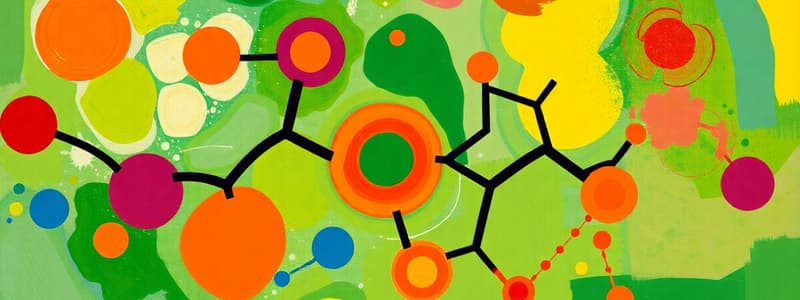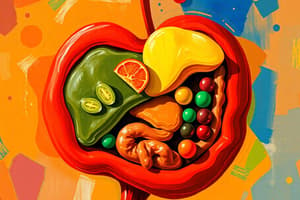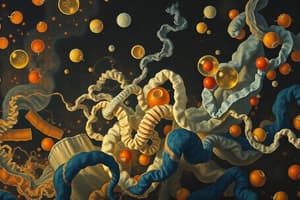Podcast
Questions and Answers
What must occur for proteins to be absorbed in the intestine?
What must occur for proteins to be absorbed in the intestine?
- They need to be broken down into di- and tripeptides as well as individual amino acids. (correct)
- They must be hydrolyzed into monosaccharides.
- They should be transformed into biogenic amines.
- They have to be converted into nucleobases.
What characterizes transamination reactions in amino acid degradation?
What characterizes transamination reactions in amino acid degradation?
- Conversion of amino acids into glucose.
- Formation of free ammonia.
- Direct synthesis of urea from amino acids.
- Transferring amino group to another molecule. (correct)
What is the primary role of the urea cycle in amino acid metabolism?
What is the primary role of the urea cycle in amino acid metabolism?
- To eliminate toxic ammonia by converting it into urea. (correct)
- To convert amino acids into energy.
- To synthesize amino acids from nitrogenous compounds.
- To store proteins for later use.
Which amino acids are exceptions regarding transamination?
Which amino acids are exceptions regarding transamination?
What occurs during oxidative deamination?
What occurs during oxidative deamination?
What is the primary function of aminotransferases in amino acid degradation?
What is the primary function of aminotransferases in amino acid degradation?
Which compound is primarily involved in receiving the amino group during transamination?
Which compound is primarily involved in receiving the amino group during transamination?
Which of the following describes a primary source of nitrogen in the urea cycle?
Which of the following describes a primary source of nitrogen in the urea cycle?
Which amino acids are categorized as nonessential and synthesized from intermediates of metabolism?
Which amino acids are categorized as nonessential and synthesized from intermediates of metabolism?
What is the primary purpose of incorporating nitrogen into the structure during amino acid synthesis?
What is the primary purpose of incorporating nitrogen into the structure during amino acid synthesis?
Which type of amino acids cannot be synthesized in mammals?
Which type of amino acids cannot be synthesized in mammals?
What are the main nitrogen sources for purine nucleotide synthesis?
What are the main nitrogen sources for purine nucleotide synthesis?
What role does histamine play in the body?
What role does histamine play in the body?
What is produced from the oxidative deamination of amino acids?
What is produced from the oxidative deamination of amino acids?
Which of the following is a product of tryptophan degradation?
Which of the following is a product of tryptophan degradation?
Which compounds result from amino acid degradation?
Which compounds result from amino acid degradation?
Flashcards
Protein digestion
Protein digestion
The process of breaking down proteins into smaller units like dipeptides, tripeptides, and individual amino acids, which can be absorbed by the intestine.
Proteolytic enzymes
Proteolytic enzymes
A group of enzymes that break down peptide bonds, which link amino acids together in proteins.
Amino acid degradation
Amino acid degradation
The breakdown of amino acids into smaller molecules, involving two main steps: separation of the amino group and metabolism of the carbon skeleton.
Transamination
Transamination
Signup and view all the flashcards
Oxidative deamination
Oxidative deamination
Signup and view all the flashcards
Urea cycle
Urea cycle
Signup and view all the flashcards
Glucogenic amino acids
Glucogenic amino acids
Signup and view all the flashcards
Ketogenic amino acids
Ketogenic amino acids
Signup and view all the flashcards
α-Carbon
α-Carbon
Signup and view all the flashcards
Pyruvate
Pyruvate
Signup and view all the flashcards
Acetyl-CoA
Acetyl-CoA
Signup and view all the flashcards
Nonessential Amino Acids
Nonessential Amino Acids
Signup and view all the flashcards
Biogenic Amines
Biogenic Amines
Signup and view all the flashcards
Nucleotide Metabolism
Nucleotide Metabolism
Signup and view all the flashcards
Purine Synthesis
Purine Synthesis
Signup and view all the flashcards
Study Notes
Metabolism of Nitrogenous Compounds
- The metabolism of nitrogenous compounds is a complex process involving proteins, amino acids, biogenic amines, porphyrins, and nucleobases.
- Learning objectives include describing protein digestion, reactions in separating amino groups, fates of carbon skeletons, glucogenic/ketogenic amino acids, biogenic amines, and examples of nitrogenous compounds.
- Contents of nitrogenous compounds include amino acids (proteins), biogenic amines, porphyrins, and nucleobases.
- Amino acid metabolism involves dietary protein degradation, protein synthesis, and use for energy or creating other compounds. Amino acids can be converted to glucose or fat. Ammonia is produced, and urea is the primary way to remove nitrogen from the body.
- Protein digestion starts in the stomach with the action of proteases, and continues in the small intestine.
- Protein digestion is crucial because large protein molecules cannot be absorbed directly. Enzymes are needed to break peptide bonds, gradually reducing the protein into smaller amino acids.
- Amino acid metabolism aims to separate the amino group (NH3) from the carbon skeleton. Transamination and oxidative deamination are important reactions for this separation.
- The process of separating the amino (NH2) group of an amino acid is vital as it determines the fate of the carbon skeleton.
- The carbon skeleton can be used for energy production through pathways such as the Krebs cycle.
- Glucogenic amino acids can be converted into glucose and ketogenic amino acids can be converted into ketone bodies.
- The urea cycle processes ammonia and converts it into urea, which can be excreted, preventing buildup of toxic ammonia.
- Important considerations in amino acid degradation include transamination (separating amino group), oxidative deamination (removing amino groups converting into ammonia), and metabolism of carbon skeletons.
- Biogenic amines are important neurotransmitters, hormones, and other molecules derived from amino acids.
Amino Acid Degradation
- Transamination transfers amino groups from one amino acid to a keto acid, forming a new amino acid and a new keto acid. This reaction is reversible.
- Oxidative deamination removes amino groups from amino acids, producing ammonia and a keto acid. Oxidative deamination is typically irreversible, generating free ammonia molecules.
- The carbon skeletons of amino acids can enter various metabolic pathways, such as the citric acid cycle (Krebs cycle), to be used for energy production or used to synthesize other substances.
- Different amino acids have different fates, classifying them as glucogenic or ketogenic based on their ability to yield glucose or ketone bodies. The process of these reactions are described in a number of images describing their pathways.
Urea Cycle
- Ammonia, a byproduct of amino acid metabolism, is toxic and needs to be converted to urea for excretion.
- The urea cycle is a series of reactions that takes place primarily in the liver, converting ammonia into urea, which is less toxic and easier to excrete.
- The urea cycle involves multiple enzymes and intermediates, with aspartate and free ammonia from protein degradation playing key roles in producing urea.
Porphyrin Degradation
- Porphyrins are complex nitrogen-containing molecules crucial to various biological processes, notably involved in oxygen transport in hemoglobin.
- Porphyrin degradation disorders are characterized by imbalances in the synthesis or degradation of porphyrins, leading to build-up of toxic intermediates in body fluids like blood and urine, which are then released into the body causing several symptoms.
Nucleotide Metabolism
- Nucleotides are the building blocks of nucleic acids (DNA and RNA).
- Nucleotide metabolism involves the synthesis and degradation of nucleotides.
- Purines and pyrimidines are the building blocks of nitrogenous bases in nucleotides.
- Nucleotide metabolism pathways include the synthesis of purines and pyrimidines from amino acids in the body.
- Synthesis of RNA and DNA involves specific pentose sugars (ribose and deoxyribose), phosphate groups and various nitrogenous bases.
Biogenic Amines
- Biogenic amines are nitrogen-containing aromatic compounds derived from amino acids, acting as neurotransmitters, hormones, and other signaling molecules.
- Tyrosine, tryptophan, histidine, and other important amines are synthesized in the body which play key roles in functions within the body, such as neurotransmission and hormone regulation.
- Biogenic amines derived from different amino acids have diverse roles—such as participating in allergic responses, influencing gastric acid secretion or being important neurotransmitters—
Studying That Suits You
Use AI to generate personalized quizzes and flashcards to suit your learning preferences.




